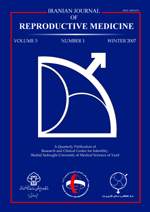
|
International Journal of Reproductive BioMedicine
Research and Clinical Center for Infertility, Shahid Sadoughi University of Medical Sciences of Yazd
ISSN: 1680-6433
EISSN: 1680-6433
Vol. 17, No. 4, 2019, pp. 245-252
|
 Bioline Code: rm19026
Bioline Code: rm19026
Full paper language: English
Document type: Research Article
Document available free of charge
|
|
|
International Journal of Reproductive BioMedicine, Vol. 17, No. 4, 2019, pp. 245-252
| en |
The therapeutic potential of amifostine on cyclophosphamide-induced testicular dysfunction in rats: An experimental study
Kaya, Coskun; Baseskioglu, Ali Barbaros; Yigitaslan, Semra; Ozatik, Fikriye Yasemin; Ozatik, Orhan & Uslu, Sema
Abstract
Background: Cyclophosphamide (CP) is a well-known alkylating anticancer agent used
in the treatment of various malignant and non-malignant tumors. CP may also cause
a variety of adverse effects, including reproductive toxicity. Amifostine is known as a
cytoprotective drug having antioxidant properties.
Objective: To evaluate the possible beneficial effects of amifostine on testicular toxicity
induced by CP in rats.
Materials and Methods: A total of 35 Sprague-Dawley rats were used in this
experimental study. The CP group animals received a single dose of 200 mg/kg
CP on Day 8 by intraperitoneal injection and were left untreated for the following
seven days. The two remaining groups of animals were treated with 200 mg/kg/day
amifostine (AMF 200) and 400 mg/kg/day amifostine (AMF 400) for seven days prior
to and following a single intraperitoneal injection of CP. Morphometrical analysis
and histological examination of testicular tissue were performed. Serum testosterone,
luteinizing hormone, and follicle-stimulating hormone levels were measured in serum
using commercial ELISA kits. The epidydimal sperm count was determined.
Results: The tubular epithelial height in the testis was significantly higher in the
AMF400 group compared to other groups (p < 0.001). Animals in the AMF400 group
showed minimal debris in the tubules, no Sertoli cell damage, and the Johnsen
scores were slightly higher in the AMF400 group. The epididymal sperm count was
significantly lower in the CP-administered animals compared to the control animals and
was significantly higher in the AMF200 and AMF400 groups compared to the CP group
(p = 0.006, and p = 0.019 respectively).
Conclusion: Amifostine, at a dose of 400 mg/kg, may have a protective effect on
testicular damage induced by CP in rats.
Keywords
Amifostine; Cyclophosphamide; Rat; Testis.
|
| |
© Copyright 2019 - Coskun Kaya et al.
Alternative site location: http://www.ijrm.ir
|
|
